Introduction
According to the results of the social survey carried out in 1997, during which most residents named water and sanitation as the issue where they would most like to see improvements, THF decided to make the improvement of water supply and sanitation facilities for the local residents into a significant element of the old city rehabilitation project. The residents complained in particular about the bad smell of their drinking water, which was obtained in many cases from hand-pumps. Water analysis carried out by THF confirmed residents' fears of polluted ground water. The piped water of Lhasa is safe, as the Lhasa Water Office pumps their water up from 60 meters deep, and regularly uses chlorine to purify the water according to China's health standards.
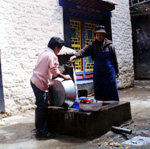
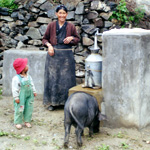
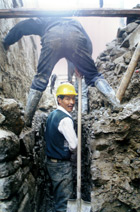
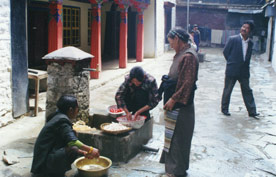 Safe and Convenient Water, Clean Courtyards, and Proper Drainage at the Old Tibetan Post Office. As part of renovating the old Tibetan Post Office (Drakhang house), THF removed refuse and soil from the courtyard, constructed two public water tapstands and extended the sewer line to the water tapstands. These improvements benefit the 230 people who live in and around the Drakhang.
Safe and Convenient Water, Clean Courtyards, and Proper Drainage at the Old Tibetan Post Office. As part of renovating the old Tibetan Post Office (Drakhang house), THF removed refuse and soil from the courtyard, constructed two public water tapstands and extended the sewer line to the water tapstands. These improvements benefit the 230 people who live in and around the Drakhang.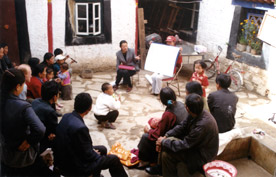 Hygiene Education for Local Residents and THF Employees. Waterborne diseases, notably hepatitis, run rampant in Lhasa. After water and sanitation improvements were completed, the two THF hygiene educators gave hygiene education talks to the local residents. In this 1999 photo, the THF hygiene educator uses THF-developed visual aids to illustrate a point. Subjects covered in the talks included: the cause, transmission and prevention of diseases and the proper care and maintenance of toilets and tapstands. After attending the hygiene education classes, residents were very appreciative of receiving knowledge that helps them protect the health of their families. In addition, the 270 THF employees also received hygiene education training.
Hygiene Education for Local Residents and THF Employees. Waterborne diseases, notably hepatitis, run rampant in Lhasa. After water and sanitation improvements were completed, the two THF hygiene educators gave hygiene education talks to the local residents. In this 1999 photo, the THF hygiene educator uses THF-developed visual aids to illustrate a point. Subjects covered in the talks included: the cause, transmission and prevention of diseases and the proper care and maintenance of toilets and tapstands. After attending the hygiene education classes, residents were very appreciative of receiving knowledge that helps them protect the health of their families. In addition, the 270 THF employees also received hygiene education training.